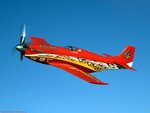Civettone
Tech Sergeant
You're talking about the Spiteful?
The data I have suggest that it didn't have a long-range capability. To me, it's simply the successor of the Spitfire. Development started rather early but was always put on low priority. The British - more than others - upgraded existing designs rather than start with a new one. Worked well in WW2...
Kris
The data I have suggest that it didn't have a long-range capability. To me, it's simply the successor of the Spitfire. Development started rather early but was always put on low priority. The British - more than others - upgraded existing designs rather than start with a new one. Worked well in WW2...
Kris


